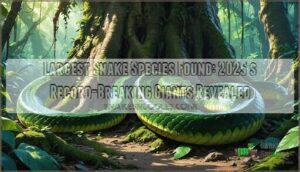This site is supported by our readers. We may earn a commission, at no cost to you, if you purchase through links.

Today’s reticulated python holds the length record at over 30 feet, while green anacondas dominate weight at 550+ pounds.
But prehistoric titans like Titanoboa cerrejonensis dwarfed modern serpents at 42 feet long and 2,500 pounds.
Recent 2024-2025 discoveries have revealed new anaconda species in Ecuador and confirmed that ancient Vasuki indicus stretched nearly 50 feet.
These colossal constrictors represent evolutionary masterpieces of power and precision, combining deadly hunting skills with mind-boggling scale that makes even today’s largest pythons seem modest by comparison, showcasing their deadly hunting skills and mind-boggling scale.
Table Of Contents
- Key Takeaways
- Largest Snake Species
- Giant Snakes Found
- Snake Size Records
- Unique Snake Features
- Notable Snake Discoveries
- Frequently Asked Questions (FAQs)
- Is this the largest snake ever discovered?
- Could a new species of snake be the biggest in the world?
- What is the largest snake in the Amazon rainforest?
- What is the heaviest snake in the world?
- What is the largest snake in South Asia?
- What is the longest snake in the world?
- Which species of snake is the largest in the world?
- Is there a 30 foot snake?
- Is the 33 foot anaconda real?
- How do snakes grow to such enormous sizes?
- Conclusion
Key Takeaways
- You’ll find today’s longest snake is the reticulated python at 32.8 feet, but the prehistoric Titanoboa dwarfed it at 42 feet long and 2,500 pounds – making modern giants look modest by comparison.
- Green anacondas dominate the weight category at 550+ pounds, while recent discoveries, like Vasuki indicus from 2024, reveal ancient serpents that stretched nearly 50 feet through prehistoric ecosystems.
- You can’t trust many record claims online – that famous 33-foot Brazilian anaconda was debunked as a photography hoax, so always verify measurements against scientific documentation.
- These massive constrictors don’t just suffocate prey – they cause cardiac arrest by cutting off blood flow, with species like Cuban boas even hunting in coordinated packs at cave entrances.
Largest Snake Species
You’ll encounter six major snake species that represent the largest living serpents on Earth today.
These giants range from the 16.5-foot Central African rock python to the record-breaking 32.8-foot reticulated python that’s known to consume humans.
Central African Rock Python
You’ll find the Central African Rock Python stretching up to 16.5 feet through sub-Saharan Africa‘s diverse habitats.
This largest snake species dominates the African ecosystem as a powerful constrictor, though habitat loss threatens its survival.
Rock Python populations face mounting pressure from deforestation and human encroachment.
Conservation efforts now focus on protecting these longest snake species and their critical wetland territories for future generations.
Understanding the largest snake breeds is essential for effective conservation strategies.
King Cobra
The King Cobra’s impressive length makes it the longest venomous snake, reaching up to 18.7 feet.
You’ll find this largest venomous snake in dense forests across Southeast Asia, where its advanced venom production system delivers potent neurotoxins.
The biggest cobra’s venom effects shut down respiratory systems within hours, making encounters with this apex predator exceptionally dangerous.
Burmese Python
You’ll encounter this massive constrictor throughout Southeast Asia, where it’s earned its reputation as one of the largest snake species.
The Burmese Python can reach staggering lengths of 18.8 feet, making it a true giant python among serpents.
Florida’s ecosystem faces serious threats from this invasive species, which has dramatically altered the Everglades’ natural balance.
Here’s what makes their Python Behavior so remarkable:
- Extraordinary navigation – They can find their way home across 20+ miles
- Powerful constriction – Causes heart attacks in prey, not just suffocation
- Incredible size – Heaviest snake specimens exceed 200 pounds
- Habitat adaptability – Thrives in diverse Burmese Habitat conditions
Cuban Boa
Cuban Boa represents one of the most fascinating largest snake species, reaching lengths up to 19.6 feet.
You’ll find these giant snake species exhibiting unique Boa Behavior – they’re the only snakes known to hunt in Snake Packs, collaborating to trap bats at cave entrances.
This Cuban Wildlife demonstrates remarkable teamwork within their Boa Habitat, making them among the biggest snake found with cooperative hunting strategies.
Indian Python
Looking at the world’s largest snake breed, you’ll discover the Indian Python reaches impressive lengths up to 21 feet and weighs 220 pounds.
These heaviest snake specimens use advanced heat sensing pits to detect prey from three feet away in their natural Indian habitat.
Their python behavior includes constricting large mammals, while their varied python diet supports essential snake conservation efforts protecting this remarkable species.
Reticulated Python
Within tropical rainforests across Southeast Asia, you’ll find the reticulated python stretching up to 32.8 feet—making it the longest snake ever recorded.
This largest reptile demonstrates remarkable snake behavior, swimming powerfully and climbing skillfully through dense python habitat.
Their reticulated diet includes mammals, birds, and occasionally humans during rare snake encounters.
Despite their impressive size, python conservation efforts help protect these magnificent predators from habitat loss.
Giant Snakes Found
You’ll discover that prehistoric giants make today’s largest snakes look like garden varieties.
These ancient serpents, including the massive Titanoboa and recently discovered Vasuki indicus, reached lengths that would dwarf any modern species by decades of feet.
Gigantophis Garstini
You’ll discover that Gigantophis garstini represents one of prehistory’s most formidable predators in ancient ecosystems.
This extinct species dominated fossil history roughly 40 million years ago, when giant reptiles ruled tropical landscapes.
Here’s what makes this prehistoric snake extraordinary:
- Size estimates: Originally calculated at 30-35 feet, later revised to 23 feet
- Weight: Approximately half a ton of pure muscle
- Prey: Hunted early elephant ancestors and ancient crocodilians
- Classification: Belonged to the extinct Madtsoiidae family of primitive constrictors
The discovery of Gigantophis is significant in understanding prehistoric snake evolution and behavior.
Palaeophis Colossaeus
Among prehistoric sea serpents, Palaeophis colossaeus dominated ancient ecosystems as the largest snake in world history.
You’ll find this marine reptile’s fossil records reveal lengths exceeding 39 feet, making it a true giant snake attack predator of prehistoric waters.
| Characteristic | Details |
|---|---|
| Length | Over 39 feet (12 meters) |
| Habitat | Ancient marine environments |
| Classification | Prehistoric sea snake |
| Time Period | Paleocene-Eocene epochs |
| Fossil Evidence |
Vertebrae and skull fragments.
This extinct snake’s massive size showcases snake evolution’s remarkable diversity.
Marine reptiles like Palaeophis colossaeus dominated prehistoric seas, hunting large fish and marine mammals with devastating efficiency.
Titanoboa Cerrejonensis
Titanoboa cerrejonensis dominated ancient ecosystems as the largest snake species ever discovered, stretching an incredible 42.7 feet long and weighing 2,500 pounds.
Fossil analysis from Colombia’s Cerrejón Formation reveals this prehistoric habitat supported massive reptiles 60 million years ago.
Snake evolution took a dramatic turn when Titanoboa ruled tropical swamps, dwarfing today’s extinct species like Gigantophis garstini through sheer prehistoric power.
Vasuki Indicus
You’ll encounter Vasuki indicus as potentially the longest snake ever discovered, with fossil analysis revealing lengths between 36-50 feet.
This prehistoric giant from Mid-Eocene India represents a pivotal link in snake evolution, showing how extinct species achieved massive sizes.
Recent fossil discoveries suggest Vasuki’s habitat supported enormous constrictors that rivaled even Gigantophis garstini in their impressive dimensions, making it a significant find in understanding snake evolution.
Madtsoiidae Family
While Vasuki indicus dominated ancient waterways, the Madtsoiidae family represents an entirely different chapter in prehistoric snake evolution.
You’ll find these extinct species scattered across multiple continents during the late Cretaceous period, showcasing remarkable diversity in ancient habitats.
- Global Distribution: Fossil records reveal Madtsoiidae snakes lived across Africa, South America, Australia, and Madagascar
- Evolutionary Timeline: These prehistoric snakes thrived for over 100 million years before going extinct
- Snake Anatomy: Possessed unique vertebral structures that distinguished them from modern constrictors like Titanoboa
- Size Variation: Species ranged from modest lengths to giants rivaling Gigantophis garstini and Palaeophis colossaeus
Snake Size Records
You’ll discover that snake size records reveal fascinating extremes among the world’s largest serpents.
These documented measurements help scientists understand the true limits of snake growth in both wild and captive environments.
Longest King Cobra
You’ll discover the longest venomous snake on record was a king cobra measuring 18.7 feet, captured at London Zoo in the 1930s.
This impressive specimen showcases how King Cobra Habitat in Southeast Asia supports remarkable growth.
The longest species of venomous snake demonstrates incredible Cobra Behavior, with some individuals rivaling the reticulated python in pure snake length through their extraordinary defensive adaptations.
Largest Burmese Python
You’ll find the largest Burmese Python in Florida reached massive proportions, weighing 215 pounds and stretching 17.7 feet long.
These invasive species have transformed Python Habitat across the Everglades, making them the heaviest snake specimens documented in North America.
Key facts about these record-breaking giants:
- Python Length: Can exceed 18 feet in ideal conditions
- Burmese Diet: Includes deer, alligators, and native wildlife
- Snake Behavior: Exceptional homing instincts spanning 20+ miles
Understanding their python habitat needs is vital for effective conservation efforts.
Green Anaconda Estimate
You’ll find the green anaconda stands as the heaviest snake species on Earth, with the Northern Green Anaconda (Eunectes akayima) reaching verified lengths of 20.7 feet and weights of 440 pounds.
This giant species demonstrates remarkable anaconda size variations, with unverified reports suggesting specimens may exceed 24 feet in length and weigh over 1,100 pounds, though record verification remains challenging in remote habitats.
The green anaconda’s massive size is a result of its adaptation to aquatic environments, which allows it to thrive in its native habitats.
Anaconda Record Debunked
That reported 33-foot green anaconda in Brazil turned out to be photography’s greatest snake hoax.
You’ll find three main red flags in debunked claims:
- Forced perspective photography – making snakes appear larger than actual size
- Unverified measurements – lacking scientific documentation or peer review
- Sensationalized media reports – tabloid websites spreading fake sightings without proper record verification
Always check anaconda measurements against established scientific standards before believing extraordinary size claims about the largest snake species.
Medusa Reticulated Python
You’ll recognize Medusa (Python reticulatus) as the longest snake ever recorded in captivity, measuring 25 feet 2 inches.
This reticulated python required fifteen handlers and consumed 40-pound deer whole.
Her Kansas City habitat featured specialized reticulated care with controlled humidity and reinforced structures.
Despite captive breeding programs, few specimens match her exceptional size, making her the undisputed champion among largest snake species.
Unique Snake Features
You’ll discover how the world’s largest snakes have evolved remarkable adaptations that go far beyond their impressive size.
These massive serpents possess extraordinary sensory abilities, hunting strategies, and physiological features that make them some of nature’s most efficient predators.
King Cobra Venom
King cobra venom delivers neurotoxic power through specialized fangs that inject lethal doses into prey.
You’ll encounter four key venom composition elements that make this snake species comparison fascinating:
- Neurotoxins – Attack nervous system function
- Cardiotoxins – Target heart muscle tissue
- Cytotoxins – Destroy cellular structures
- Hyaluronidase – Spreads toxic effects rapidly
Antivenom treatment remains critical for snake bites survival.
Researchers study venom product properties to develop effective treatments.
Burmese Python Homing
Beyond deadly venom, you’ll discover Burmese pythons possess extraordinary Python Navigation abilities.
These snakes demonstrate remarkable homing instincts, returning home after traveling 13-22 miles away.
Snake navigation research reveals Python bivittatus uses both map and compass senses for Animal Orientation.
Wildlife Tracking studies show their snake homing surpasses all other species, with straighter movement paths than random wandering during Snake Migration.
Cuban Boa Hunting
Unlike other largest snake species that hunt solo, you’ll find Cuban boas employing remarkable pack hunting strategies at cave entrances.
These boa constrictors coordinate their ambush techniques, positioning themselves strategically to capture bats in flight.
Their collective prey capture methods represent unique hunting strategies among snakes, making them fascinating subjects for snake conservation research and demonstrating sophisticated snake tactics rarely observed in reptilian behavior.
The success of such strategies often relies on proper snake hunting gear, including reptile handling equipment, which is crucial for effective snake conservation.
Indian Python Heat Pits
Beyond simple sight, you’ll find the Indian python’s heat pits create a sophisticated thermal imaging system.
These pit organs detect infrared radiation from warm-blooded prey up to 3.2 feet away.
Snake vision combines with heat sensing to form detailed thermal maps of their environment.
This infrared detection gives Python reticulatus hunting advantages even in complete darkness.
The ability to detect heat is made possible by advanced infrared detection systems, which is a key factor in their hunting advantages.
Constriction Method
You’ve likely wondered how constrictor snakes actually kill their prey.
The constriction method doesn’t simply suffocate victims—it causes cardiac arrest by cutting off blood flow to essential organs.
Reticulated python, boa constrictor, and green anaconda species use this deadly hunting tactic with precision.
Snake predation through constriction proves far more efficient than venom effects, making these giants nature’s ultimate ambush predators.
Understanding the different types of constricting snakes is essential to appreciating their unique characteristics and behaviors.
Notable Snake Discoveries
You’ll discover remarkable fossil finds that have revolutionized our understanding of ancient serpent giants.
Recent excavations have unearthed species like Titanoboa cerrejonensis and Vasuki indicus, while modern technology helps scientists separate genuine discoveries from elaborate hoaxes, leading to a better understanding of these ancient creatures and their remarkable characteristics.
Titanoboa Fossil Discovery
The 2009 discovery of Titanoboa cerrejonensis fossils in Colombia’s Cerrejón coal mine revolutionized our understanding of prehistoric ecosystems.
This Colombian coal mine discovery unveiled Earth’s most colossal serpent, rewriting prehistoric predator history forever.
You’ll find these 58-million-year-old remains represent the largest snake species ever documented, stretching up to 50 feet long and weighing over 2,500 pounds.
- Fossil Analysis revealed 186 specimens from at least 30 individual giant snakes
- Snake Evolution studies show Titanoboa dominated post-dinosaur South American rainforests
- Prehistoric Ecosystems included 13-foot crocodiles and 8-foot turtles alongside these extinct species
- Giant Reptiles thrived in warmer Paleocene climates that supported massive body sizes
- Extinct Snakes like Titanoboa provide vital insights into ancient biodiversity and climate patterns
Vasuki Indicus Unearthed
Scientists unearthed Vasuki indicus fossils in an Indian mine during April 2024, revealing another prehistoric giant that rivaled Titanoboa’s massive proportions.
This extinct species measured 35-50 feet long, making it potentially the largest snake species ever discovered.
| Vasuki Discovery Details | Specifications |
|---|---|
| Location Found | Indian mine site |
| Discovery Date | April 2024 |
| Estimated Length | 35-50 feet (10.9-15.2 meters) |
| Time Period | Mid-Eocene Epoch |
Fossil analysis suggests Vasuki indicus used ambush predation tactics, constricting prey like modern boas.
This massive snake discovery reshapes our understanding of snake evolution and prehistoric giants that once dominated ancient ecosystems.
Giant Snake Hoaxes
The internet’s full of fake snake sightings that’ll make your jaw drop—until you discover they’re complete hoaxes.
Snake photo manipulation techniques create convincing images of massive snake discoveries that fool millions.
Giant snake legends spread faster than wildfire through social media, but hoax investigations reveal the truth.
Debunked records include that infamous giant anaconda allegedly measuring 33 feet, exposed through forced perspective photography tricks.
Belo Monte Dam Snake Sightings
Unlike hoaxes that fool millions online, Dam Encounters at Brazil’s Belo Monte revealed a legitimate river monster.
Construction workers discovered a giant anaconda measuring 32.8 feet after controlled explosions disturbed its Snake Habitat.
This Amazon Species exemplifies how Water Ecology changes affect wildlife.
The green anaconda, weighing 880 pounds, represents authentic documentation of nature’s biggest snake discoveries in threatened river systems.
Largest Anaconda Records
You’ll find that verified green anaconda records tell a different story than sensational claims.
Giant anaconda records separate scientific fact from internet fiction—the truth is impressive enough.
Ana Julia, a northern green anaconda, measured 26 feet and weighed 440 pounds, representing legitimate record breakers among giant species.
The largest snake in world discussions often confuse green anaconda habitat facts with hoaxes.
While reticulated python specimens like Medusa hold captivity records, anaconda length measurements remain scientifically contested, making the biggest snake in world debate complex.
Frequently Asked Questions (FAQs)
Is this the largest snake ever discovered?
Titanoboa cerrejonensis stretched an incredible 7 feet long and weighed 2,500 pounds.
However, you’re looking at the largest extinct snake, not currently living species.
Today’s reticulated pythons max out around 8 feet, making Titanoboa the undisputed heavyweight champion of serpentine history.
Could a new species of snake be the biggest in the world?
Scientists can’t rule out discovering new snake species that might break current records. You’d need complete fossil evidence and rigorous taxonomic analysis to confirm any potential record-breaker surpasses today’s giants.
What is the largest snake in the Amazon rainforest?
You’ll find the green anaconda (Eunectes murinus) reigning as the Amazon’s largest snake. These massive constrictors can reach over 20 feet long and weigh 440 pounds, making them true aquatic giants.
What is the heaviest snake in the world?
Looking for the heaviest snake on Earth? You’ll find the green anaconda (Eunectes murinus) holds this title, with specimens reaching up to 550 pounds while measuring around 17-20 feet long.
What is the largest snake in South Asia?
The Indian python (Python molurus) dominates South Asia, stretching up to 21 feet and weighing 220 pounds.
You’ll find this powerful constrictor using heat-sensing pits to hunt prey across the subcontinent’s diverse landscapes.
What is the longest snake in the world?
When size matters, you’ll find the reticulated python (Malayopython reticulatus) reigns supreme as the world’s longest snake.
It reaches up to 8 feet in length and is capable of consuming humans through powerful constriction.
Which species of snake is the largest in the world?
You’ll find the reticulated python (Malayopython reticulatus) holds the title as the world’s largest snake species, reaching lengths up to 8 feet and capable of consuming humans.
Is there a 30 foot snake?
You won’t find a living 30-foot snake today. The largest living species, reticulated pythons, max out around 33 feet, but verified records stay under 26 feet. Prehistoric Titanoboa reached 42 feet though!
Is the 33 foot anaconda real?
No, the 33-foot anaconda reported in Brazil in 2016 was debunked as a hoax.
You’re looking at forced perspective photography that made the snake appear massive when it wasn’t actually that large.
How do snakes grow to such enormous sizes?
You’ll find enormous snakes achieve their massive size through ideal environmental conditions, abundant prey, slow metabolism, and genetic factors that allow continuous growth throughout their extended lifespans in tropical climates.
Conclusion
Modern giants like reticulated pythons stretch over 30 feet while ancient behemoths dominated prehistoric landscapes.
Today’s largest snake species found in nature pale beside extinct titans like Titanoboa cerrejonensis, which reached 42 feet and weighed 2,500 pounds.
Recent discoveries continue revealing new anaconda species and fossil records pushing size limits further.
These serpentine giants represent nature’s ultimate predators, combining massive scale with lethal efficiency that continues fascinating researchers worldwide.
- https://www.nationalgeographic.com/animals/reptiles/facts/green-anaconda
- https://www.worldatlas.com/animals/scientists-discover-the-world-s-largest-snake-species.html
- https://www.nhm.ac.uk/discover/what-is-the-biggest-snake-in-the-world.html
- https://www.ultimatekilimanjaro.com/10-biggest-snakes-in-the-world/
- https://en.wikipedia.org/wiki/List_of_largest_snakes


















